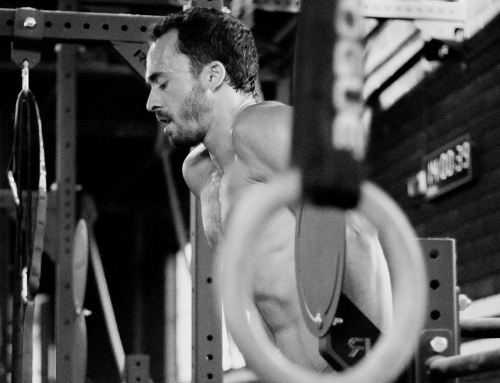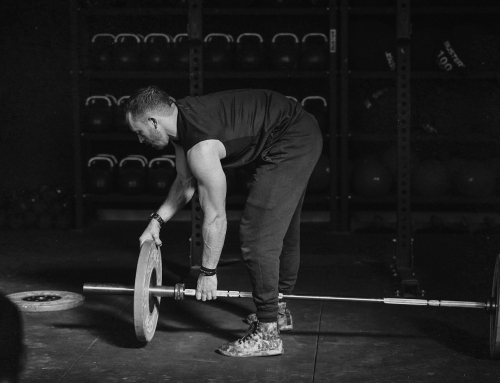Introducción
Los suplementos de aminoácidos se ha demostrado que reduce potencialmente el dolor muscular inducido por el ejercicio. Por lo tanto, el propósito de este estudio fue examinar si los aminoácidos de cadena ramificada junto con hidratos de carbono (BCAACHO) atenuarían el daño muscular sucesivo al entreno de fuerza, en mayor medida que una ingesta solamente de hidratos de carbono (CHO).
Método
30 hombres entrenados se sometierón a pruebas (T1), con lo que: 1) tuvierón una extracción de sangre basal, 2) realizarón ejercicio de cuádriceps, en la extensora, con contracciones isométrica e isocinética, y se midió la actividad del musculo con un electromiograma (EMG) a 60 ° / s y 120 ° / s, y 3) Después realizarón una repetición máxima 1-RM de sentadilla. Los participantes completarón 10 series x 5 repeticiones al 80% de su 1RM sentadilla con barra durante 3 días consecutivos y 48 h después de la tercera prueba los participantes regresaron para la prueba (T2). Inmediatamente después y 24 horas después de los 3 días de entrenamiento, los 30 participantes fueron asignados al azar a consumir uno de los dos suplementos deportivos en 600 ml de agua del grifo: 1) BCAA y CHO (3 g / d L-leucina, 1 g / d L-isoleucina y 2 g / d L-valina con 2 g de CHO; n = 15), o 2) solamente 42 g de CHO (n = 15). Además, los resultados de los análisis de sangre se señalarón 24 h después del primer y segundo entrenamiento y 48 h después del tercero para evaluar las concentraciones de mioglobina en suero, durante y después del protocolo 3-D para medir las percepciones subjetivas de dolor muscular.
Resultados
Hubo disminuciones similares en el entreno de 1RM en los dos grupos de BCAA-CHO y CHO. Las concentraciones séricas de mioglobina (p = 0,027) y el dolor muscular percibido (p <0,001) aumentó durante ambos protocolos de entreno, independientemente de la suplementación.
Conclusión
La suplementación con AACR-CHO no frenó la disminución de la fuerza del tren inferior ni mejoró los marcadores de daño muscular/dolor en comparación con la administración de suplementos de CHO durante los tres días consecutivos de entrenamiento intenso del tren inferior.
Referencias
- Clarkson PM, Hubal MJ. Exercise-induced muscle damage in humans. Am J Phys Med Rehabil. 2002;81(11):S52–69.PubMedView ArticleGoogle Scholar
- Clarkson PM, Nosaka K, Braun B. Muscle function after exercise-induced muscle damage and rapid adaptation. Med Sci Sports Exerc. 1992;24(5):512–20.PubMedGoogle Scholar
- Kraemer WJ, Spiering BA, Volek JS, Martin GJ, Howard RL, Ratamess NA, et al. Recovery from a national collegiate athletic association division I football game: muscle damage and hormonal status. J Strength Cond Res. 2009;23(1):2–10.PubMedView ArticleGoogle Scholar
- Twist C, Eston R. The effects of exercise-induced muscle damage on maximal intensity intermittent exercise performance. Eur J Appl Physiol. 2005;94(5–6):652–8.PubMedView ArticleGoogle Scholar
- Juhn MS. Popular sports supplements and ergogenic aids. Sports Med. 2003;33(12):921–39.PubMedView ArticleGoogle Scholar
- Maughan R. Nutritional ergogenic aids and exercise performance. Nutr Res Rev. 1999;12(02):255–80.PubMedView ArticleGoogle Scholar
- Hulmi JJ, Lockwood CM, Stout JR. Review Effect of protein/essential amino acids and resistance training on skeletal muscle hypertrophy: A case for whey protein. Nutr Metab. 2010;7:51.View ArticleGoogle Scholar
- Ha E, Zemel MB. Functional properties of whey, whey components, and essential amino acids: mechanisms underlying health benefits for active people (review). J Nutr Biochem. 2003;14(5):251–8.PubMedView ArticleGoogle Scholar
- Tang JE, Moore DR, Kujbida GW, Tarnopolsky MA, Phillips SM. Ingestion of whey hydrolysate, casein, or soy protein isolate: effects on mixed muscle protein synthesis at rest and following resistance exercise in young men. J Appl Physiol. 2009;107(3):987–92.PubMedView ArticleGoogle Scholar
- Nicastro H, da Luz CR, Chaves DFS, Bechara LRG, Voltarelli VA, Rogero MM et al. Does branched-chain amino acids supplementation modulate skeletal muscle remodeling through inflammation modulation? Possible mechanisms of action. J Nutr Metab. 2012;2012:1-10.
- Jackman SR, Witard OC, Jeukendrup AE, Tipton KD. Branched-chain amino acid ingestion can ameliorate soreness from eccentric exercise. Med Sci Sports Exerc. 2010;42(5):962–70.PubMedView ArticleGoogle Scholar
- Howatson G, Hoad M, Goodall S, Tallent J, Bell PG, French DN. Exercise-induced muscle damage is reduced in resistance-trained males by branched chain amino acids: a randomized, double-blind, placebo controlled study. J Int Soc Sports Nutr. 2012;9(1):20.PubMedPubMed CentralView ArticleGoogle Scholar
- Sharp CP, Pearson DR. Amino acid supplements and recovery from high-intensity resistance training. J Strength Cond Res. 2010;24(4):1125–30.PubMedView ArticleGoogle Scholar
- Nosaka K, Sacco P, Mawatari K. Effects of amino acid supplementation on muscle soreness and damage. Int J Sport Nutr Exerc Metab. 2006;16(6):620.PubMedView ArticleGoogle Scholar
- White JP, Wilson JM, Austin KG, Greer BK, St John N, Panton LB. Effect of carbohydrate-protein supplement timing on acute exercise-induced muscle damage. J Int Soc Sports Nutr. 2008;5(1):1–7.View ArticleGoogle Scholar
- Stock MS, Young JC, Golding LA, Kruskall LJ, Tandy RD, Conway-Klaassen JM, et al. The effects of adding leucine to pre and postexercise carbohydrate beverages on acute muscle recovery from resistance training. J Strength Cond Res. 2010;24(8):2211–9.PubMedView ArticleGoogle Scholar
- Tipton KD, Ferrando AA, Phillips SM, Doyle Jr D, Wolfe RR. Postexercise net protein synthesis in human muscle from orally administered amino acids. Am J Phys. 1999;276(4 Pt 1):E628–34.Google Scholar
- Data N. SelfNutritionData. http://nutritiondata.self.com/. 2006. 2015.
- BOBBERT MF, HOLLANDER AP, Huijing P. Factors in delayed onset muscular soreness. Med Sci Sports Exerc. 1986;18:75–81.PubMedView ArticleGoogle Scholar
- Basmajian JV, De Luca C. Muscles alive. Proc R Soc Med. 1985;278:126.Google Scholar
- Sorichter S, Puschendorf B, Mair J. Skeletal muscle injury induced by eccentric muscle action: muscle proteins as markers of muscle fiber injury. Exerc Immunol Rev. 1998;5:5–21.Google Scholar
- Kirby TJ, Triplett NT, Haines TL, Skinner JW, Fairbrother KR, McBride JM. Effect of leucine supplementation on indices of muscle damage following drop jumps and resistance exercise. Amino Acids. 2012;42(5):1987–96.PubMedView ArticleGoogle Scholar
- Blomstrand E, Eliasson J, Karlsson HK, Köhnke R. Branched-chain amino acids activate key enzymes in protein synthesis after physical exercise. J Nutr. 2006;136(1):269S–73.PubMedGoogle Scholar
- Norton LE, Layman DK. Leucine regulates translation initiation of protein synthesis in skeletal muscle after exercise. J Nutr. 2006;136(2):533S–7.PubMedGoogle Scholar
- Anthony JC, Anthony TG, Kimball SR, Jefferson LS. Signaling pathways involved in translational control of protein synthesis in skeletal muscle by leucine. J Nutr. 2001;131(3):856S–60.PubMedGoogle Scholar
- Tipton K, Gurkin B, Matin S, Wolfe R. Nonessential amino acids are not necessary to stimulate net muscle protein synthesis in healthy volunteers. J Nutr Biochem. 1999;10(2):89–95.PubMedView ArticleGoogle Scholar
- Matsumoto K, Mizuno M, Mizuno T, Dilling-Hansen B, Lahoz A, Bertelsen V, et al. Branched-chain amino acids and arginine supplementation attenuates skeletal muscle proteolysis induced by moderate exercise in young individuals. Int J Sports Med. 2007;28(6):531–8.PubMedView ArticleGoogle Scholar
- Louard RJ, Barrett EJ, Gelfand RA. Overnight branched-chain amino acid infusion causes sustained suppression of muscle proteolysis. Metabolism. 1995;44(4):424–9.PubMedView ArticleGoogle Scholar
- Busquets S, Alvarez B, Llovera M, Agell N, López‐Soriano FJ, Argilés JM. Branched‐chain amino acids inhibit proteolysis in rat skeletal muscle: mechanisms involved. J Cell Physiol. 2000;184(3):380–4.PubMedView ArticleGoogle Scholar
- Shimomura Y, Inaguma A, Watanabe S, Yamamoto Y, Muramatsu Y, Bajotto G, et al. Branched-chain amino acid supplementation before squat exercise and delayed-onset muscle soreness. Int J Sport Nutr. 2010;20(3):236.Google Scholar
- Field CJ, Gougeon R, Marliss EB. Circulating mononuclear cell numbers and function during intense exercise and recovery. J Appl Physiol. 1991;71(3):1089–97.PubMedGoogle Scholar
- Kraemer WJ, Clemson A, Triplett NT, Bush JA, Newton RU, Lynch JM. The effects of plasma cortisol elevation on total and differential leukocyte counts in response to heavy-resistance exercise. Eur J Appl Physiol Occup Physiol. 1996;73(1):93–7.PubMedView ArticleGoogle Scholar
- Nieman DC, Nehlsen-Cannarella SL, Fagoaga OR, Henson DA, Utter A, Davis JM, et al. Effects of mode and carbohydrate on the granulocyte and monocyte response to intensive, prolonged exercise. J Appl Physiol. 1998;84(4):1252–9.PubMedGoogle Scholar
- Peake JM. Exercise-induced alterations in neutrophil degranulation and respiratory burst activity: possible mechanisms of action. Exerc Immunol Rev. 2002;8:49–100.PubMedGoogle Scholar
- Suzuki K, Sato H, Kikuchi T, Abe T, Nakaji S, Sugawara K, et al. Capacity of circulating neutrophils to produce reactive oxygen species after exhaustive exercise. J Appl Physiol. 1996;81(3):1213–22.PubMedGoogle Scholar
- Suzuki K, Totsuka M, Nakaji S, Yamada M, Kudoh S, Liu Q, et al. Endurance exercise causes interaction among stress hormones, cytokines, neutrophil dynamics, and muscle damage. J Appl Physiol. 1999;87(4):1360–7.PubMedGoogle Scholar
- Malm C, Nyberg P, Engström M, Sjödin B, Lenkei R, Ekblom B, et al. Immunological changes in human skeletal muscle and blood after eccentric exercise and multiple biopsies. J Physiol. 2000;529(1):243–62.PubMedPubMed CentralView ArticleGoogle Scholar
- Chieng W-S, Lee S-C. Discrepancy between initial high expression of interest in clinical cancer genetic testing and actual low uptake in an Asian population. Genet Test Mol Biomarkers. 2012;16(7):785–93.PubMedView ArticleGoogle Scholar








